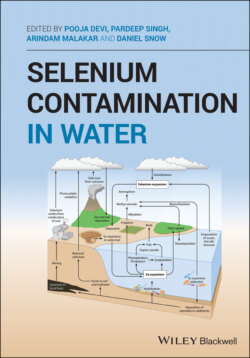Читать книгу Selenium Contamination in Water - Группа авторов - Страница 37
3.2.1 Natural Sources
ОглавлениеA variety of elements in the environment are combined with Se due to its complex chemical behavior and these Se compounds are widespread in the rocks, soils, water, and air. It is distributed in the atmosphere by processes such as volcanic activity, hot springs, weathering of soils and rocks, forest wildfires, movement of groundwater, chemical and biological redox reactions beneath the soil, and mineral formations. The occurrence of Se in the soil or in water sources depends mainly on the climate, topography, and parental material (El‐Ramady et al. 2014b). Minerals such as sulfide minerals are associated with selenite‐ and selenide‐containing rocks. The erosion of these rocks is responsible for the occurrence of Se in soils in the form of elemental Se, for instance selenite salts, ferric selenite, or in its organic form (Malisa 2001). The anionic forms of Se, i.e. selenite and selenate, are highly soluble, bio‐available, mobile, and toxic above certain limits. Decomposition of plant which accumulate Se are the sources of organic forms of Se.
The available level of Se in soil is mainly dependent on the texture of soil, rainfall, the kind of soil, and the concentration of organic matter. The lowest concentration of Se is obtained in sandy soils while the highest is in organic and calcareous soil. The major Se‐controlling factors in the soil are Eh and pH whereas other parameters like organic ligands, clay, and hydroxides also play a significant role. The worldwide occurrence of Se is in very broad range from 0.005 to 3.5 mg/kg. The concentration of Se in plants depends on the surrounding soil’s Se levels (Sakizadeh et al. 2016). A greater amount of selenate is taken up by plants than selenite and it is metabolized in chloroplasts by pathways similar to sulfur.
Se originates in water from the soil leaching and atmospheric deposits. The Se can form a stable complex with particulate or colloidal matter or sediments or can be dissolved in water. The movement of Se from the top layer is governed by the transport phenomenon and hence Se can occur in water as suspended or dissolved fraction (El‐Ramady et al. 2014b).
The concentration of Se in sea water varies between 0.1 to 0.35 μg/l (Gaillardet et al. 2003). Natural waters have a concentration less than 1 μg/l (Conde and Sanz Alaejos 1997). Global Se average concentration in river waters is given in the range of 0.02–0.5 μg/l while in groundwater and surface water it ranges from 0.06 to 400 μg/l (World Health Organization 2011). The concentration of Se in water is dependent upon pH. The compounds which are soluble in water are converted at high and low pH and this results in an increase in concentration.
Se can be transported to the air by natural processes such as volcanic eruptions, soil erosion, forest fires, and evaporation from ocean and sea. Mosses and peats in marine regions with increased Se levels when volatilized release Se into the air in the form of hydrogen selenide and elemental Se, selenites, and selenates in particulate form. Hydrogen selenide and Se dioxide are unstable in the air and are converted by oxidation into Se and H2O and into selenicious acid in moist conditions (Belcher et al. 1980). The ambient air Se concentration is generally very low and varies from 0.1 to 10 ng/m3 (Lee and Duffield 1979; Gilbert and Fornes 1980).
The presence of Se in grains and vegetables is mainly accountable for the Se contents of soil in which they grow. The natural concentration of Se is very low, i.e. approximately 6 mg/g in vegetables like carrot, tomatoes, potatoes, cucumber, etc., even if they are grown in seleniferous soils. Some vegetables effectively accumulate Se from seleniferous soil, for instance onions and asparagus accumulate up to 17 μg/g. Fruits accumulate very low Se which is less than 10 μg/kg (Whanger 2004).
